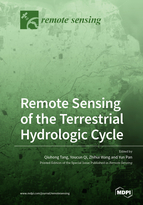Remote Sensing of the Terrestrial Hydrologic Cycle
A special issue of Remote Sensing (ISSN 2072-4292). This special issue belongs to the section "Biogeosciences Remote Sensing".
Deadline for manuscript submissions: closed (31 January 2020) | Viewed by 47221
Special Issue Editors
Interests: water cycle; remote sensing hydrology; land surface modeling; global change; water resources
Special Issues, Collections and Topics in MDPI journals
Interests: radar-based quantitative precipitation estimation; short-term quantitative precipitation forecast
Special Issues, Collections and Topics in MDPI journals
Interests: satellite and airborne image processing; vegetation mapping; land surface parameters inversion; hydrologic modeling; water cycle response to a changing environment
Interests: satellite gravimetry; groundwater hydrology; terrestrial water storage change
Special Issues, Collections and Topics in MDPI journals
Special Issue Information
Dear Colleagues,
Our understanding of the terrestrial hydrologic cycle has benefited from the emerging remote sensing technologies in recent decades. With the increased capacity of satellite, airborne, and ground sensors (e.g., optical, gravity, microwave, LiDAR, weather radar) from low to high spatial–temporal–spectral–radiometric resolutions, the key variables of the hydrologic cycle (e.g., precipitation, evapotranspiration, soil moisture, terrestrial water storage, groundwater, water body, wetland, snow, ice and glaciers, streamflow) can be obtained at varying spatial and temporal resolutions and accuracies via remote sensing. Applications of remote sensing provide unprecedented opportunities to advance the simulation, monitoring, and prediction of the terrestrial hydrologic cycle, and have been widely used in flood/landslide/mudslide hazard prevention and water management. Numerous remote sensing techniques and retrieval methods have been developed to improve the estimation accuracy of hydrologic variables. Data assimilation techniques have been integrating remote sensing observations and in-situ measurements to assist operational hydrologic practices. Has the hydrologic community exhausted the full potential of remote sensing?
This Special Issue aims to advance innovative remote sensing methods for improving our understanding of the terrestrial hydrologic cycle and to stimulate innovations to meet the needs of hydrologic practice. We encourage the submission of manuscripts related to all aspects of remote sensing-assisted hydrologic applications, including the estimation of water-related variables, hydrologic data assimilation, operational hydrometeorological practice, smart water management, and water hazards analysis. We welcome studies using new remote sensing sensors/platforms and combining emerging technologies such as artificial intelligence and big data analytics.
Prof. Qiuhong Tang
Prof. Youcun Qi
Dr. Zhihui Wang
Prof. Yun Pan
Guest Editors
Manuscript Submission Information
Manuscripts should be submitted online at www.mdpi.com by registering and logging in to this website. Once you are registered, click here to go to the submission form. Manuscripts can be submitted until the deadline. All submissions that pass pre-check are peer-reviewed. Accepted papers will be published continuously in the journal (as soon as accepted) and will be listed together on the special issue website. Research articles, review articles as well as short communications are invited. For planned papers, a title and short abstract (about 100 words) can be sent to the Editorial Office for announcement on this website.
Submitted manuscripts should not have been published previously, nor be under consideration for publication elsewhere (except conference proceedings papers). All manuscripts are thoroughly refereed through a single-blind peer-review process. A guide for authors and other relevant information for submission of manuscripts is available on the Instructions for Authors page. Remote Sensing is an international peer-reviewed open access semimonthly journal published by MDPI.
Please visit the Instructions for Authors page before submitting a manuscript. The Article Processing Charge (APC) for publication in this open access journal is 2700 CHF (Swiss Francs). Submitted papers should be well formatted and use good English. Authors may use MDPI's English editing service prior to publication or during author revisions.
Keywords
- satellite
- airborne
- weather radar
- hydrologic cycle
- water hazards
- water management









